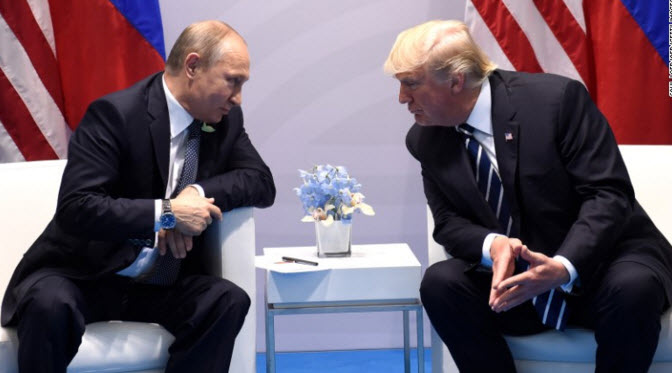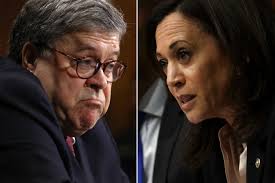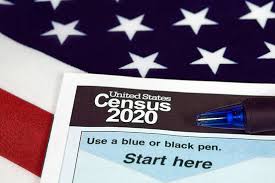Donald Trump and Vladimir Putin spoke by phone for an hour on May 3rd, agreeing that the two-year Mueller investigation was a “Russian hoax”, imaginary intrusions into the 2016 election apparently, and, as Trump said to reporters, the Mueller report “ended up being a mouse”. The question of Russian intervention in the 2020 election? Trump said it did not come up.
Other subjects discussed sounded optimistic and mutually beneficial, but on this topic our president once again is in accord with Putin’s claim of no election 
interference — he memorably said, standing alongside Putin in Helsinki, “I don’t see why they would” — and elects to ignore the overwhelming evidence of the Mueller report and his own intelligence services. Just days earlier, FBI Director Christopher Wray said what…
“has continued pretty much unabated is the use of social media, fake news, propaganda, false personas, etc…. pretty much a 365 days a year threat… just kind of a dress rehearsal for the big show in 2020.”
Trump shows no interest in combating the Russian interference that helped him get elected in 2016, while at the same time equating any discussion of malign Russian activity as questioning the legitimacy of his winning the presidency — his “Achilles heel”, as former aide Hope Hicks put it. Acting Chief of Staff Mick Mulvaney even warned fired Homeland Security Secretary Kirstjen Nielsen to make no mention in front of Trump of her department’s efforts to stop Russian meddling in the 2020 election. Mulvaney told her it “wasn’t a great subject and should be below his level”.
doubling down on obstruction
Trump also wants any further investigations silenced. “We’re fighting all the subpoenas”, he said, stiffing Congress’ constitutional right of oversight of the executive branch, refusing to provide any documents to the several investigative committees, claiming executive privilege to disallow former White House counsel Don McGahn and others from testifying, and pleased with an attorney general who lied to Congress and refused to appear before the House Judiciary committee. Can there be any doubt that Putin cheered him on. “Constitutional crisis” has regularly been declared by politicians and the media during the Trump years, often leaving us to wonder just what part of the Constitution they had in mind, but this time we have the real thing.
disappearing half the report
Now appears a 5-page letter to Attorney General William Barr, written by White House counsel Emmet Flood, that slams the Mueller report for being “political” for saying the president could not be exonerated from claims of obstructing justice. Flood argues that Mueller should have acted as a prosecutor and come to an explicit judgment. He writes, “What prosecutors are supposed to do is complete an investigation and then either ask the grand jury to return an indictment or decline to charge the case”. But indicting a sitting president was not an option for Mueller, according to 
Attorney General William Barr faces off
against Senator Kamala Harris
guidelines of the Justice Department’s Office of Legal Counsel, and by “decline to charge the case” Flood means that if you can’t indict, say nothing. Flood is attempting to undo the second half of Mueller’s statement that “While this report does not conclude that the President committed a crime, it also does not exonerate him”. Flood effectively says there should have been no Volume 2 about obstruction in the report, that any implication of obstruction by the president should have been silenced, that there should be no mention of the 10 instances that Mueller lays out for consideration by others, namely Congress.
Dropping all decorum, Flood calls the report, a “prosecutorial curiosity” that’s “part ‘truth commission’ report and part law school exam paper”. His incivility was subsequently matched by Barr in the Senate hearing, when he said Mueller’s letter to him expressing dissatisfaction with Barr’s mischaracterization of 22 months of work was “a bit snitty and I think it was probably written by one of his staff people”.
Without Flood’s prior urging, Barr, serving as the president’s lawyer rather than the people’s lawyer, was already of like mind it’s safe to say. He has even said that the president cannot obstruct because it’s his justice department to do with as he pleases, no matter the special counsel regulations. In the hearing, Iowa Republican Chuck Grassley asked, “Was it Special Counsel responsibility to make a charging recommendation?”. Barr answered, “I think that if he felt that he shouldn’t go down the path of making a traditional prosecutive decision, then he shouldn’t have investigated” obstruction at all. No Volume 2.
This was an attempt to twist Mueller’s mandate into something it wasn’t. He was charged with investigating and submitting a report. Presidential hopeful Kamala Harris, herself a former prosecutor who would exhibit those skills in the hearing that had Barr floundering for answers, said emphatically:
“The report is a report. If you have it in front of you you will see the cover page of that 400-plus page document. It calls itself, because it is, “a report”…It is not a file of evidence. It is a report on an investigation.”
Barbara McQuade, a United States attorney until 2017, now a professor at the University of Michigan Law School, shows how Barr’s and Flood’s position is a deliberate perversion because it “couldn’t exist”. Barr…
“keeps using that phrase…prosecutors must charge or don’t charge. That is true in an ordinary case, but this is not an ordinary case, because what he’s also saying is you can’t charge the president…you can only clear the president. That’s the only thing you can do … so we can have a report that says, ‘nothing wrong. as you were'”.
no collusion, no crime
The other argument that Trump supporters have used to negate the obstruction evidence is “it’s not obstruction if there was no underlying crime”. Setting aside that Volume I is rife with Russian contacts and a willingness to benefit “from information stolen and released through Russian efforts”, that argument is wrong on the face of it as both law and logic. It hopes to obscure that a healthy percentage of investigations is to discover whether or not a crime has been committed. It implausibly says that, for lack of yet knowing the answer, such an investigation can be freely obstructed without its being obstruction.
That is the case here — Mueller’s team was looking for whether there was any conspiring or coordinating with Russian elements behind all the puzzling connections with Russians during the 2016 campaign. Imagine if Trump’s obstruction had been successful, that he had shut down the investigation, that this was ruled not obstruction because proof of a crime was not yet in hand. That gives license to obstruct at will, a law for dictators.
Which concords with what Attorney General Barr thinks, as he said in the May 1st Senate hearing:
“If in fact a proceeding was not well founded, if it was a groundless proceeding, if it was based on false allegations, the president does not have to sit there constitutionally and allow it to run its course. The president could terminate that proceeding, and it would not be a corrupt intent because he was being falsely accused.”
Dwell on that for a moment — from the highest legal officer in the land. A president is free to decide on his own that accusations against him are false. He can decide not to be investigated if he doesn’t want to be. And this was no slip of tongue. In the 19-page job application that signaled to Trump that he had finally found his Roy Cohn, Barr wrote,
“A president does not act ‘corruptly’ simply by acting on — even terminating — a matter that relates to his own conduct”.
Hillary Clinton showed up to call this “the road to tyranny”. How is it not?
bag man
The hearing revealed an attorney general for whom equivocate and prevaricate must be favorite words, but who had also done an unprofessional job in evaluating the report. Kamala Harris exposed that neither Barr, his deputy Rod Rosenstein, nor staff had read the evidence materials — notes, e-mail, witness testimony, interviews — that underlay Barr’s conclusion that there was no obstruction. “We accepted the statements in the report as the factual record,” Barr said. “We did not go underneath it to see whether or not they were accurate; we accepted it as accurate”. Ms Harris seemed amazed: “Yet you represented to the American public that the evidence was not, quote, sufficient, to support an obstruction of justice offense”, she responded, and asked if as attorney general he would ever accept a declination to prosecute from a U.S. attorney who said he had not reviewed all the evidence.
Harris had opened her inquiry by asking, “Has the president or anyone at the White House ever asked or suggested that you open an investigation of anyone”. Barr replied, “Um, I wouldn’t, I wouldn’t, um…”
Harris: “Yes or no”.
Barr: (long pause) “Could you repeat that question?”.
He then said he was having difficulty “grappling” with the word “suggested” and never did answer, clearly avoiding the choice of admitting that targeting is true or, by answering “no”, to be perjuring himself if the truth proves otherwise.
The evasion prompted Harris to ask the Inspector General of the Justice Department by letter to investigate whether the Attorney General “has received or acted upon requests or suggestions…to investigate the President’s perceived enemies”.
Another presidential aspirant, Sen. Cory Booker, uncovered that Barr, who had said “no collusion” four times in releasing the report, didn’t know about the most flagrant act of collusion of all, Paul Manafort’s repeated passing of the campaign’s own polling data to Konstantin Kilimnik, who the report said has ties to Russian intelligence services. “What information was shared?” Barr asked. “Polling data was shared, sir,” Booker replied. “It’s in the report. I can cite you the page.” “With who?” Barr asked. Did Barr read the report on which he passed judgment?
Four Democrats called for him to resign, to no effect of course. One of them, Sen. Mazie Hirono of Hawaii said in the hearing, “The American people know that you are no different from Rudy Giuliani or Kellyanne Conway or any of the other people who sacrificed their once-decent reputation for the grifter and liar who sits in the Oval Office”.
She could have added the liar that sits in the attorney general’s office. In a previous hearing, Barr had lied to Congress. Representative Charlie Crist (D-Fla) brought up the Mueller team’s “frustration” with Barr’s four-page summary of their report. Crist asked, “Do you know what they’re referencing with that?”. Barr had received Mueller’s letter of chastisement before testifying, and knew full well that it said his summarization “did not fully capture the context, nature, and substance of this Office’s work and conclusions”, yet to the question of whether he knew why Mueller was discontented, Barr answered, “No, I don’t”.
House Speaker Nancy Pelosi said, “He lied to Congress” and said it again for good measure. “Nobody is above the law. Not the president of the United States and not the attorney general”. Her comments were called by Kerri Kupec at the Department of Justice “reckless, irresponsible, and false”, the last apparently in the Groucho Marx sense of “Who are you going to believe, Kupec or your own ears?”.
whose baby?
Barr wanted to put Mueller in his place (except it’s a place well above his own in the public’s view), referring to him as “Bob” in a Senate hearing in a sign of disrespect to display dominance: “You know, Bob Mueller”, using the special counsel’s first name in a sign of disrespect and to display dominance,
“is the equivalent of a U.S. attorney. He was exercising the powers of the attorney general, subject to the supervision of the attorney general. He’s part of the Department of Justice. His work concluded when he sent his report to the attorney general. At that point, it was my baby. It was my decision how and when to make it public, not Bob Mueller’s”.
Neal Katyal has been the 2nd level Solicitor General of the United States, but more notably is fresh from arguing his 39th case before the Supreme Court. His view differing from Barr’s as to whose baby it is and who decides to make it public carries weight, for Katyal was the one who drafted the special counsel regulations in 1998-99. Barr has evidently not read them. Katyal says that inquiries such as Mueller’s “have one ultimate destination: Congress. That is where this process is going, and has to go”. For the attorney general to contend that the report is his “baby” and that he has sole discretion over its release does not square with the Special Counsel Regulations which mention Congress 91 times.
Mueller understood that Justice rules prevented him from indicting; Barr’s duplicity was to undercut Mueller by saying no, he wasn’t constrained by that guideline, so that Barr could arrange for himself to close out the case of obstruction. In a New York Times piece, Katyal says, “Mr. Barr tried to spin these facts” and “he hid Mr. Mueller’s complaints, which were delivered to him in writing more than a month ago”. Barr testified that he “overrode” the regulations to release the report to the public; Katyal says he overrode nothing; the special counsel regulations allow public release. Barr “put his thumb on the scale” by “pre-clearing” the president in advance of the report’s submission to Congress. “The attorney general was misleading through and through, not just about the investigation, but about the special counsel regulations themselves.”
Katyal acknowledges that it is difficult to get around an attorney general lodged in the executive branch. In the expectation that there would someday be a nefarious attorney general who interfered with an investigation or its release, the regulations have “break glass in case of emergency” option (Katyal’s words) whereby the special counsel can leave the Justice Department and testify before Congress.
That moment is eagerly awaited.
May 10 2019 | Posted in
Governance |
Read More »




